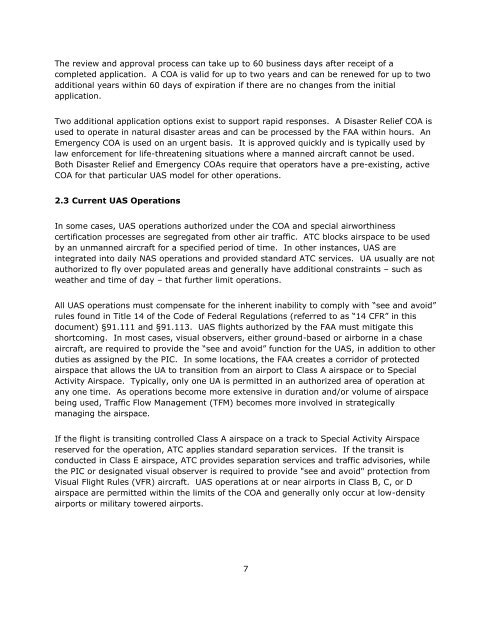FAA-UAS-Conops-Version-2-0-1
FAA-UAS-Conops-Version-2-0-1
FAA-UAS-Conops-Version-2-0-1
Create successful ePaper yourself
Turn your PDF publications into a flip-book with our unique Google optimized e-Paper software.
The review and approval process can take up to 60 business days after receipt of a<br />
completed application. A COA is valid for up to two years and can be renewed for up to two<br />
additional years within 60 days of expiration if there are no changes from the initial<br />
application.<br />
Two additional application options exist to support rapid responses. A Disaster Relief COA is<br />
used to operate in natural disaster areas and can be processed by the <strong>FAA</strong> within hours. An<br />
Emergency COA is used on an urgent basis. It is approved quickly and is typically used by<br />
law enforcement for life-threatening situations where a manned aircraft cannot be used.<br />
Both Disaster Relief and Emergency COAs require that operators have a pre-existing, active<br />
COA for that particular <strong>UAS</strong> model for other operations.<br />
2.3 Current <strong>UAS</strong> Operations<br />
In some cases, <strong>UAS</strong> operations authorized under the COA and special airworthiness<br />
certification processes are segregated from other air traffic. ATC blocks airspace to be used<br />
by an unmanned aircraft for a specified period of time. In other instances, <strong>UAS</strong> are<br />
integrated into daily NAS operations and provided standard ATC services. UA usually are not<br />
authorized to fly over populated areas and generally have additional constraints – such as<br />
weather and time of day – that further limit operations.<br />
All <strong>UAS</strong> operations must compensate for the inherent inability to comply with “see and avoid”<br />
rules found in Title 14 of the Code of Federal Regulations (referred to as “14 CFR” in this<br />
document) §91.111 and §91.113. <strong>UAS</strong> flights authorized by the <strong>FAA</strong> must mitigate this<br />
shortcoming. In most cases, visual observers, either ground-based or airborne in a chase<br />
aircraft, are required to provide the “see and avoid” function for the <strong>UAS</strong>, in addition to other<br />
duties as assigned by the PIC. In some locations, the <strong>FAA</strong> creates a corridor of protected<br />
airspace that allows the UA to transition from an airport to Class A airspace or to Special<br />
Activity Airspace. Typically, only one UA is permitted in an authorized area of operation at<br />
any one time. As operations become more extensive in duration and/or volume of airspace<br />
being used, Traffic Flow Management (TFM) becomes more involved in strategically<br />
managing the airspace.<br />
If the flight is transiting controlled Class A airspace on a track to Special Activity Airspace<br />
reserved for the operation, ATC applies standard separation services. If the transit is<br />
conducted in Class E airspace, ATC provides separation services and traffic advisories, while<br />
the PIC or designated visual observer is required to provide "see and avoid" protection from<br />
Visual Flight Rules (VFR) aircraft. <strong>UAS</strong> operations at or near airports in Class B, C, or D<br />
airspace are permitted within the limits of the COA and generally only occur at low-density<br />
airports or military towered airports.<br />
7


